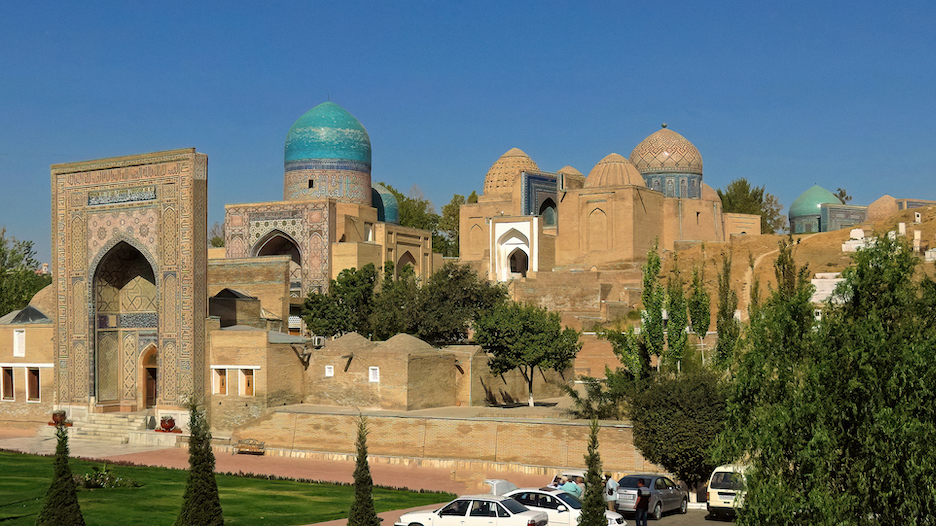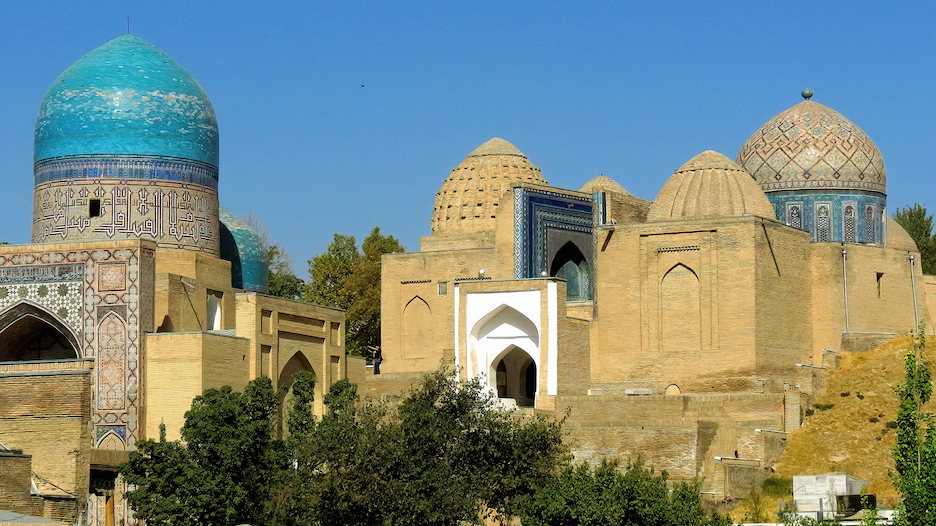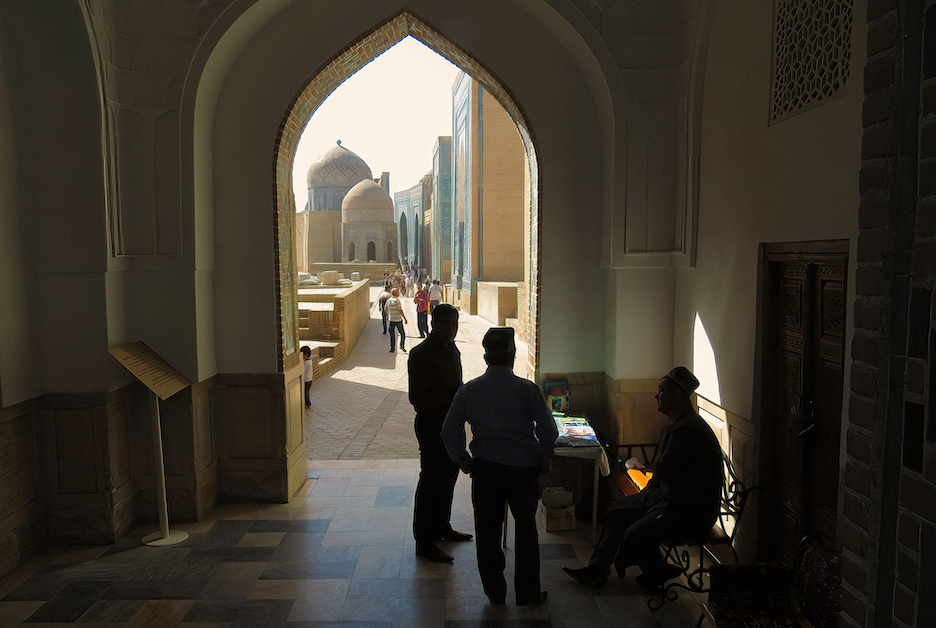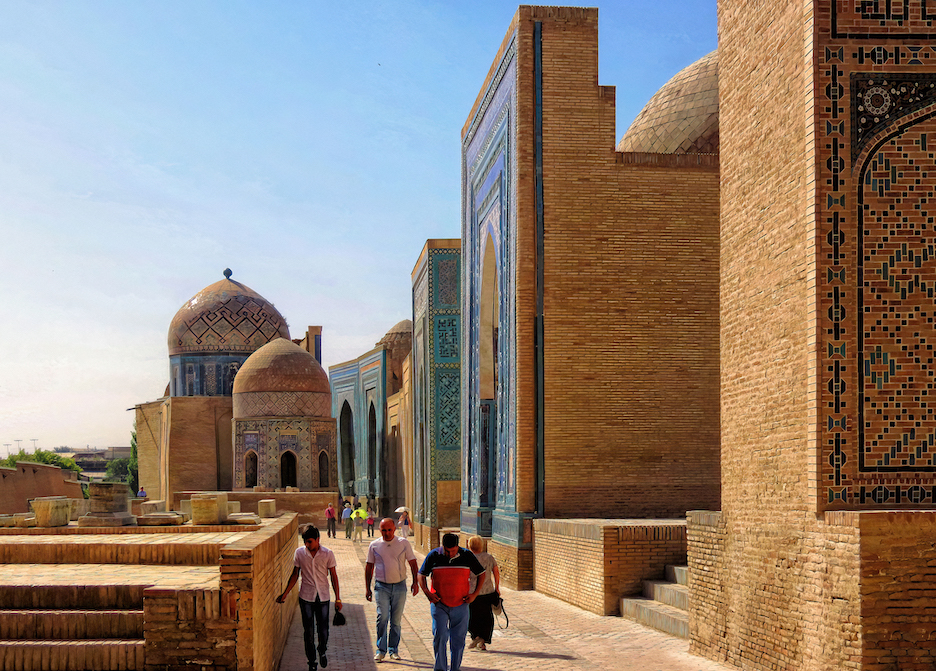Shakhi Zinda: A Timeless Ode to Samarkand’s Cultural Splendor Part 1 of 3
Nov 15, 2023 20:11:10 #
MosheR
Loc: New York City
You are now going to have a bit of a look at the architectural necropolis of Shakhi Zinda, one of the main reasons most tourists, including my wife and me who have been there twice, actually go to such an off the beaten path place such as Samarkand. Beyond its breathtaking tilework, which puts to shame everything else the city I’ve posted so far. and its historic significance, Shakhi Zinda is more than just a resting place and memorial for the dead—it is a living testament to Uzbekistan's rich cultural heritage.
The name "Shakhi Zinda" translates to "Alive King" in Persian, and the complex is a repository of centuries of history. Its origins date back about a thousand years ago to the 11th century, and it has witnessed the ebb and flow of empires, from the Samanids to the Timurids, which I wrote about in an earlier posting. (I’m sure that Samarkand was not on most of your minds for most of your lives, now here you are, most of you are senior citizens, and you’re reading and learning so much about this place that you never before gave a rat’s ass about. Isn’t technology wonderful? ) The mausoleums and tombs within Shakhi Zinda are a testament to the spiritual and cultural richness that has characterized this region for centuries.
Shakhi Zinda's architectural brilliance lies in its intricate tilework, vibrant colors, and harmonious blend of various Islamic architectural styles. The mausoleums and structures, adorned with calligraphy and geometric patterns, create a mesmerizing visual spectacle. Each tomb reflects the craftsmanship and artistic ingenuity of the period it represents, making Shakhi Zinda a living museum of Central Asian architecture.
The complex is anchored by the mausoleum of Qusam ibn-Abbas, a cousin of the Prophet Muhammad, giving the site immense spiritual importance for Muslims. Pilgrims and visitors alike are drawn to the spiritual energy that permeates Shakhi Zinda, making it a revered destination for both cultural exploration and religious reverence. And its in - person beauty, which these poor photos only give mild a hint at, is absolutely mind blowing.
Beyond its architectural allure, Shakhi Zinda is a symbol of Samarkand’s multicultural tapestry. The complex houses tombs and mausoleums dedicated to individuals from various cultural and ethnic backgrounds, reflecting the historical convergence of diverse communities along the Silk Road. This cultural amalgamation is mirrored in the art and inscriptions found throughout the site, creating a visual narrative of the region's cosmopolitan history.
The cultural richness of Shakhi Zinda is not confined to its historical structures alone. The Shakhi Zinda Ensemble, a musical group named after this illustrious complex, breathes life into the site through its performances there. We were not lucky enough to see them when we visited, but we were told that the ensemble's music captures the essence of Uzbekistan's classical and folk traditions, creating a sonic bridge between the past and the present. So I’m relating that information, although second hand, here.
Shakhi Zinda, with its architectural splendor and cultural significance, stands as a beacon of Uzbekistan's enduring heritage. As a testament to the nation's rich past and diverse cultural influences, it invites visitors to explore the layers of history within its walls. Through the Shakhi Zinda Ensemble and continued preservation efforts, this site remains a living connection to the cultural tapestry of Central Asia, inviting all who visit to witness the timeless beauty and spirit of Samarkand and Uzbekistan.
The name "Shakhi Zinda" translates to "Alive King" in Persian, and the complex is a repository of centuries of history. Its origins date back about a thousand years ago to the 11th century, and it has witnessed the ebb and flow of empires, from the Samanids to the Timurids, which I wrote about in an earlier posting. (I’m sure that Samarkand was not on most of your minds for most of your lives, now here you are, most of you are senior citizens, and you’re reading and learning so much about this place that you never before gave a rat’s ass about. Isn’t technology wonderful? ) The mausoleums and tombs within Shakhi Zinda are a testament to the spiritual and cultural richness that has characterized this region for centuries.
Shakhi Zinda's architectural brilliance lies in its intricate tilework, vibrant colors, and harmonious blend of various Islamic architectural styles. The mausoleums and structures, adorned with calligraphy and geometric patterns, create a mesmerizing visual spectacle. Each tomb reflects the craftsmanship and artistic ingenuity of the period it represents, making Shakhi Zinda a living museum of Central Asian architecture.
The complex is anchored by the mausoleum of Qusam ibn-Abbas, a cousin of the Prophet Muhammad, giving the site immense spiritual importance for Muslims. Pilgrims and visitors alike are drawn to the spiritual energy that permeates Shakhi Zinda, making it a revered destination for both cultural exploration and religious reverence. And its in - person beauty, which these poor photos only give mild a hint at, is absolutely mind blowing.
Beyond its architectural allure, Shakhi Zinda is a symbol of Samarkand’s multicultural tapestry. The complex houses tombs and mausoleums dedicated to individuals from various cultural and ethnic backgrounds, reflecting the historical convergence of diverse communities along the Silk Road. This cultural amalgamation is mirrored in the art and inscriptions found throughout the site, creating a visual narrative of the region's cosmopolitan history.
The cultural richness of Shakhi Zinda is not confined to its historical structures alone. The Shakhi Zinda Ensemble, a musical group named after this illustrious complex, breathes life into the site through its performances there. We were not lucky enough to see them when we visited, but we were told that the ensemble's music captures the essence of Uzbekistan's classical and folk traditions, creating a sonic bridge between the past and the present. So I’m relating that information, although second hand, here.
Shakhi Zinda, with its architectural splendor and cultural significance, stands as a beacon of Uzbekistan's enduring heritage. As a testament to the nation's rich past and diverse cultural influences, it invites visitors to explore the layers of history within its walls. Through the Shakhi Zinda Ensemble and continued preservation efforts, this site remains a living connection to the cultural tapestry of Central Asia, inviting all who visit to witness the timeless beauty and spirit of Samarkand and Uzbekistan.
Just look at that!! You can see the main entrance to the complex all the way to the left. After that, as you can also see, you walk through another series of entrances until you finally actually get inside.

A zoomed in view, taken from the same vantage point, of what you saw in the previous shot.

This is the final one of the series of entrances that lead into the main avenues of the complex. In the next photo, after we pay for our tickets at that little table, we step through that last open doorway.

And this is what we see when we step inside. I originally cloned out those people before posting. Then I decided, they were there, so why not. National Geo doesn't clone out people, so why should I?

Nov 15, 2023 20:53:48 #
Nov 15, 2023 23:21:47 #
MosheR wrote:
You are now going to have a bit of a look at the a... (show quote)
You are a great writer, but I'm not sure our imaginations could start to picture all this without great photos too. It's just too awesome for words.
Nov 15, 2023 23:33:23 #
Nov 16, 2023 00:23:30 #
MosheR
Loc: New York City
Horseart wrote:
You are a great writer, but I'm not sure our imaginations could start to picture all this without great photos too. It's just too awesome for words.
Awwww. What can I say but thank you, Jo, so very, very much.
Nov 16, 2023 00:23:43 #
Nov 16, 2023 00:26:35 #
MosheR
Loc: New York City
UTMike wrote:
Interesting architecture, Mel.
That is probably an understatement, Mike.
Nov 16, 2023 06:33:44 #
Nov 16, 2023 08:10:19 #
Nov 16, 2023 08:20:58 #
Nov 16, 2023 08:21:08 #
Nov 16, 2023 10:34:23 #
Nov 16, 2023 18:48:04 #
MosheR wrote:
You are now going to have a bit of a look at the a... (show quote)
Excellent pictures and cultural information. Thanks for sharing.
Also today on CNN website, there was this article on Samarkand with link below
https://www.cnn.com/travel/samarkand-uzbekistan-guide/index.html
Nov 16, 2023 19:10:49 #
Nov 16, 2023 22:45:37 #
If you want to reply, then register here. Registration is free and your account is created instantly, so you can post right away.






